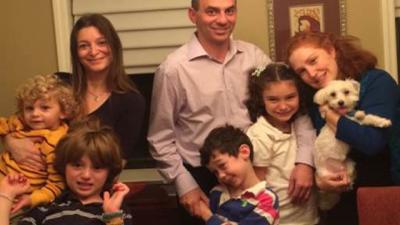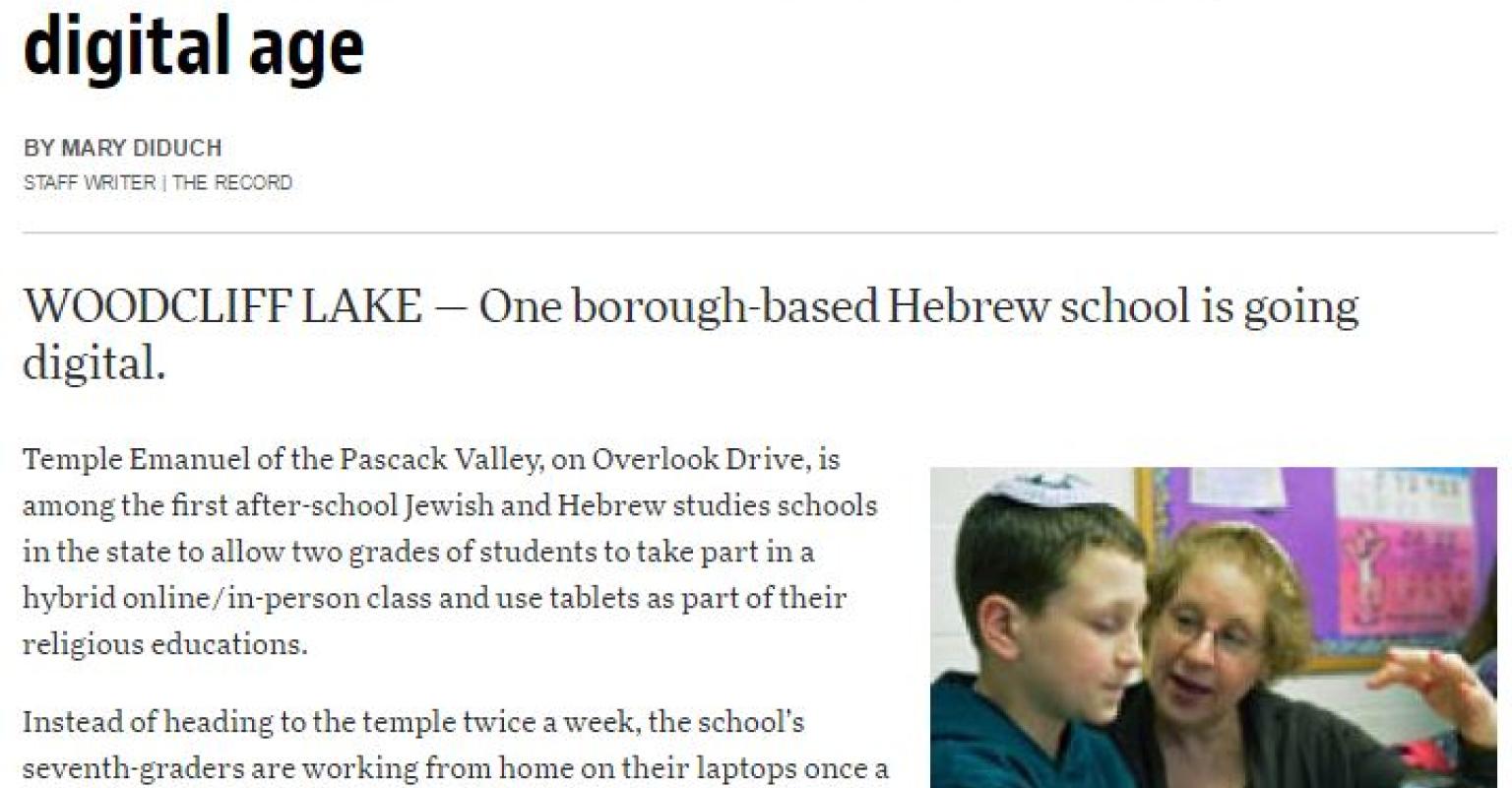Family Learning Model: MASA
Temple Shaaray Tefila, New York, NY

Model Summary:
MASA (the Hebrew word means journey) is an innovative program designed to serve as an option for those who would like a family-oriented Religious School experience. The goals of MASA include providing opportunities for parents and children to come together to learn and experience Jewish life in a more flexible setting. Each family journey will include opportunities for families to be together, for parents to learn with and from other parents, and for children to work with other children. In addition to exploring a path of Jewish content, journeys are meant to bring Temple families together to build relationships with one another and connections to the Shaaray Tefila community. Families choose to participate in one of two journeys. The first journey, Celebrations: Jewish Values Through the Jewish Year, is an opportunity for families to explore Jewish values and mitzvot while celebrating the Jewish holidays. The second journey, Family, Friends, and Foes, takes families through the Torah, learning about biblical characters and exploring their sometimes complicated relationships.
Who are the Learners?
Learners are families who are members of the synagogue with children in grades K-7. Younger siblings in preschool are also included. The ideal size for a “journey” group is about 25 families.
Who are the Educators/Learning Facilitators?
A MASA coordinator who oversees a team of 5 teachers: two HUC students, a music teacher, and two additional teachers. These teachers also teach in the weekday program.
When Does the Learning Happen?
MASA takes place approximately twice a month on Sundays from 3:00-5:30 pm, on some Shabbatot and most Jewish holidays. There is an additional Hebrew requirement, outside of MASA time, for third through seventh-grade participants.
While the exact schedule of each MASA experience is unique, the following is a basic schedule:
| 3:00 pm | Get-to-Know-You Activities and Singing (Families together) |
| 3:15 pm | Introduction to the Learning for the Day (Families together) |
| 3:30 pm | Adult Learning Session |
| Student Learning Sessions (students are grouped by grades, e.g. K-3, 4-5, and 6-7) |
|
| Snack | |
| 4:15 pm | Family Activity |
| 5:10 pm | Family T’filah Service |
| 5:30 pm | Goodbye |
Where Does the Learning Happen?
-
In the building: in the social hall and in classrooms, sometimes on the roof.
-
In homes: Twice a year families have Shabbat dinner hosted by another family.
- In the community: Twice a year families participate in a Mitzvah day (e.g. soup kitchen).
What is the Learning? How is it Designed?
There are two MASA tracks:
-
Family, Friends, and Foes – Relationships in the Bible. This is a thematic exploration of relationships, e.g. siblings (competition, reconciliation, honoring), parents, friends, romantic, friendships.
- Celebrations – Jewish values through the Jewish year. This connects a Jewish value to each holiday.
Both tracks feature Camp-inspired learning:
-
Multi-generational learning
-
Four Madrichim from Crane Lake Camp
-
Music
-
Use of space and time in a more creative way – expanding the boundaries of the classroom
-
Roleplay, simulations, kinesthetic learning
-
Staff are more like counselors, students can make choices about their learning.
- Opening and closing ritual for every session
Students in grades 3-7 choose from a number of options to fulfill an additional Hebrew language requirement. MASA is their Judaica learning experience, an alternative to the traditional two days a week Hebrew school.
What Were You Trying to Achieve with this Model?
-
MASA grew out of the congregation’s process of designing a new education model during its participation in The RE-IMAGINE Project. Core elements of the congregation’s vision for education included connecting Jewish learning to Jewish living, providing an opportunity for choice around when learning took place, and what the content would be.
-
The addition of a Hebrew tutoring component at the learner’s convenience is another example of providing choice for families within the structure of MASA.
-
The present model is an outgrowth of the previous MASA model as it existed in years 1-4.
- Through parent feedback, the MASA curriculum took on a new structure based on a more camp-inspired framework.
Key First Steps and Recruitment Plan:
-
Outreach to preschool families takes place in the spring through a MASA open house.
- There is a MASA website as well as a bulletin board display with pictures from MASA sessions in the Religious school hallway.
Role of governance and Clergy:
The clergy are supportive and join the learning on various occasions.
Budget:
Note: The following budget reflects the participation of approximately 75 families.
Tuition costs the same as a regular religious school.
| Salaries: Program Coordinator | $10,000 |
| Teachers (3@$4000) | $12,000 |
| Babysitters (2@1800) | $3,600 |
| Program Materials and Supplies: | $4,000 |
| Festival Food: | $2,500 |
| Special Activities: | $1,000 |
| Total: | $33,100 |
Hiring Needs:
The ideal educators are people who have camp experience and are open to non-traditional forms of learning. They are flexible and take initiative when appropriate.
Professional Learning happens for half an hour before a MASA session once a month. The learning focuses on a variety of topics such as building relationships with students and parents, personal growth, creative curriculum design, powerful learning, etc.
Relationship of Model to Congregational Learning System:
MASA is an alternative to Temple Shaaray Tefila’s traditional religious school.
How Do You Describe Your Congregation?
-
Reform Congregation in New York City with approximately 1500 family units.
-
A senior rabbi, an associate rabbi (who oversees professional staff and youth engagement), two cantors, two education directors, and an early childhood director, and a youth director serve the congregation.
-
Temple Shaaray Tefila’s overall educational vision is to provide the means for the congregational community to nurture and to continue its life-long involvement in Judaism by instilling a love of Jewish heritage, a shared connection within the warmth of worship, a devotion to community, and a renewed strength in Jewish identity. This vision permeates the education that is developed for this model.
Supplementary Materials Include:
- Models-In-Action
- Intergenerational Learning
- Shabbat
- After School and Beyond
- Congregational Learning
- Family Engagement
- Educator Training
- After School and Beyond
Discover more

Family Learning Models focus on families both learning and growing Jewishly through shared experiences and study.

Temple Adat Elohim, Thousand Oaks, CA. Families come together twice a month, once to experience Shabbat as a B’Yachad community and another time to help heal the world by participating in Tikkun Olam (repairing the world) projects

Temple Emanuel of the Pascack Valley (TEPV), Woodcliff Lake, NJ. This online, opt-in, home-based learning model for 7th-9th graders is a partnership with JETS Israel (Jerusalem EdTech Solutions).
